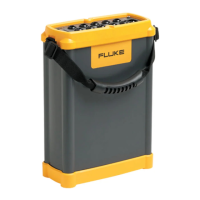Power Recorder
Verification Tests
13
17. Set the calibrator to 1000 V 10 kHz.
18. Connect the voltage test cable to UUT voltage input J for approximately 15 seconds,
then disconnect. Note, this signal is designated G in Power Analyze.
19. Press STBY on the calibrator.
20. Set the calibrator to 0 V 0 Hz.
To Use Power Analyze to Verify the Amplitude Accuracy of Recorded Impulse Events
21. Wait two minutes for the UUT to compile event information.
22. Click on 1750 Download, and then Save.
23. Click on View Recorded, and then Events.
24. On the right side, verify that all four Volts selections are checked and all five Amps
selections are unchecked in Phase Selection, and Phase to Neutral is selected in
Voltage Reference.
25. Click on Event Detector.
26. Select all channels the same and set both AN and the NG thresholds to 50 %.
27. Click Done.
28. Click on View > Table View > Top Table View. This changes the Event Summary
data at the top of the screen from graph-view to table-view.
29. Click on View > Screen View > Top Full Screen. This provides a full screen view
of the Event Summary table.
30. The following steps concern the two right-hand columns in the Event Summary table,
the Absolute and Triggered Phase columns.
31. Starting from Event 1, scroll down the table through the NG Triggered Phase data
until the AN Triggered Phase data is reached. This group of NG Triggered Phase data
is from the Normalize Thresholds section of this check. It is not used for verification.
32. Scroll down through the AN Triggered Phase data until the BN Triggered Phase data
is reached. Record the sixth-to-last AN Triggered Phase Absolute value in Table 8.
33. Scroll down through the BN Triggered Phase data until CN is reached.
34. Record the sixth-to-last BN Triggered Phase Absolute value in Table 8.
35. Scroll down through the CN Triggered Phase data until N-triggered data is reached.
Because voltage events on N cause triggers on
AN, BN, CN, and NG, (resulting in
any one of these labels) this can be most easily distinguished by the change in the
Absolute values from the CN Triggered Phase data. Record the sixth-to-last CN
Triggered Phase Absolute value in Table 8.
36. Scroll down through the N-triggered data until G-triggered data is reached. As with
the previous step this can be most easily distinguished by the change in the Absolute
values from the Triggered Phase data.
37. Record the sixth-to-last N-triggered Phase Absolute value in Table 8.
38. Scroll to the bottom of the Event Table until the end of the G-triggered data is
reached. These will all show up as NG for Triggered Phase.
39. Record the sixth-to-last N-triggered Phase Absolute value in Table 8.

